Legally, “material responsibility” refers to an employee’s responsibility regarding a company’s material assets. Yet, the theme of responsibility in the Blaffer’s current exhibitions—and both artists’ deft exploration of diverse materials—begs a new definition for the term. Blake Rayne and Analia Saban manipulate paint and other media to shirk, challenge or subvert everyday responsibilities.
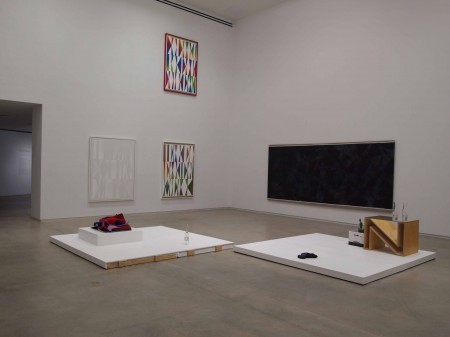
Viewing Rayne’s mid-career survey, I realized something about how I consume art: titles. As a poet, I appreciate them. They redeem many short poems that might otherwise be considered pedestrian, and I’m starting to realize that I put the same pressure on the titles of individual pieces of art. Titles can be pretentious and vague, but they also often add another dimension to the piece. I noticed it here because 19 out of 30 pieces are untitled. I still enjoyed them, but it made me feel ungrounded.
On the other hand, there’s the unhelpful title of the exhibition: “Cabin of the Accused.” The program informs us that the title “Cabin of the Accused” “combines two words associated with opposite implications, describing a paradoxical architecture that sets into relation recreation and detention.” Unless there are specialized, industry-specific definitions of these words I’m missing, I can’t agree that those opposite implications actually exist. Is it because the accused wouldn’t be in a cabin? Is it because cabin implies a rustic or homey nature, and the works themselves address modern perils of communication and disruption?
And who, exactly, is accused? We who view the art? Or is the artist accusing his subjects—language, media message, image too easily distorted?
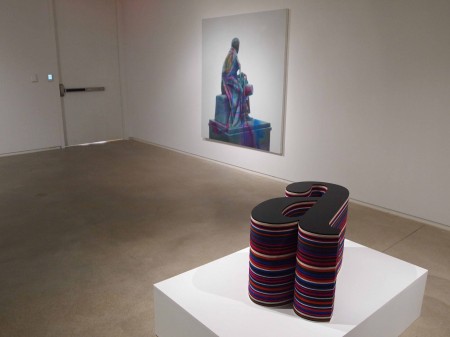
The caveat of being a midcareer “survey” doesn’t exempt this lack of cohesion, while the individual pieces are still well-done. The curators have, in this case, put a larger-than-usual interpretive responsibility on the viewer.
Still, I’m up for the challenge. Rayne’s confrontation of processes, communication and production shows how actions and items have consequences, and suggests that we disrupt them. “Interference” is a clear theme: a painting of a graffitied statue, felt letters cut from a book, t-shirts bearing leftover kitschy prints ironed over each other in loudmouthed cacophony.

“Yogurt Cinema” is particularly striking, in meaning if not visually. A small projector uses a carton-dumped lump of yogurt as a screen for its neon squiggle film. The attendant told me they change the yogurt once per week, when it starts to mold. While biological decay in a gallery setting is hardly new, as with exhibitions involving fresh fruit, the act of draining becomes most important—the film is draining the yogurt, the way outside “input” takes a toll on our own organic matter.
Where Rayne’s survey lacks cohesion, Saban’s revels in it, though pieces come from various series dating back to 2005. An almost uniform color palette of natural-brown linen canvasses and sandy concrete act as background throughout. A large ball of what looks like string greets the viewer. Its title reveals more: “Taking The Painting Ball (48 Abstract, 42 Landscapes, 23 Still Lives, 11 Portraits, 2 Religious, 1 Nude).” Analia Saban is literally deconstructing painting’s function, preparing the viewer to be destabilized without giving too much away.
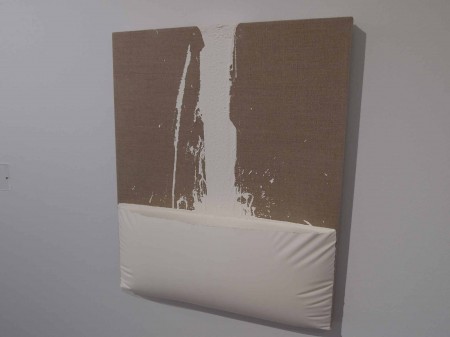
As the presence of the Painting Ball suggests, paint takes a subverted role here, primarily as a sculptural material. “Decant (White) #1” is a great example: the encaustic paint has been poured and molded into a smooth, 3-D reservoir. “Bulge (Black) #1” looks like a beach ball in a trash bag protruding from its wall mount, but is also molded encaustic paint. The indefinable force pulsing out from the wall, in this case, appears to be domestic suppression, in its plain palette and altering states.
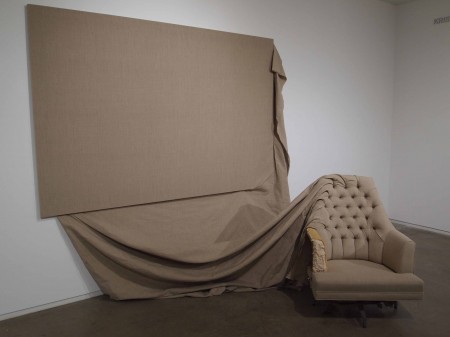
Household objects like trash bags and fitted sheets are among the paint molds and cast a critical eye upon domesticity in an unobvious way: Saban’s careful reconstruction of these objects, their pseudo-realism, shows a non-functional devotion approaching reverence. “Claim (from Chair)” consumes both canvas and furniture—it’s impossible to separate art and home. Similarly, “Marking (from Porcelain Bathroom Sink)” is an immediate communiqué of cause and effect. Objects and the duties associated with them affect, claim, and leave their mark.
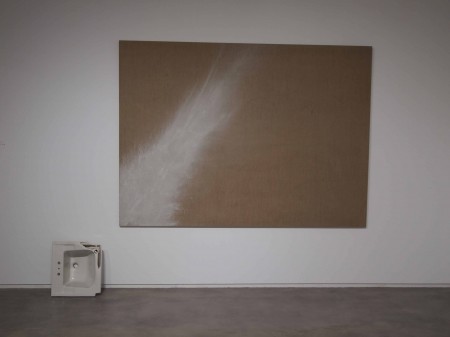
Mineral elements also appear, bringing a new heft without deviating significantly from the color pallete. “Draped Marble (Fior di Pesco Carnico, Fior di Pesco Apuano, Crema Dorlion, Onyx)” begs closer examination—Saban has here manipulated the stone to hang like towels on a drying rack. Exquisitely mangled, this piece also introduces the only pop pale pink in the exhibition, and the most severe texture.
The only other color disruption isn’t immediately obvious; “Trough (Flesh)” has been the heavilycirculated press photo for the show, but it doesn’t show the deep brown-yellow oil paint weighing down the canvas. This wouldn’t have been as striking if it was the same smooth white as the other paintings—Saban offers us a jolt of hidden ugliness weighing down her creation.
Similarly, ugliness lurks in the titles of two particular pieces: “Brush Gag” and “Concrete Gag.” The word “gag” on these two seemingly simple pieces immediately captures the violence lurking behind the gentle color scheme, and give the objects a definitively negative action to perform.
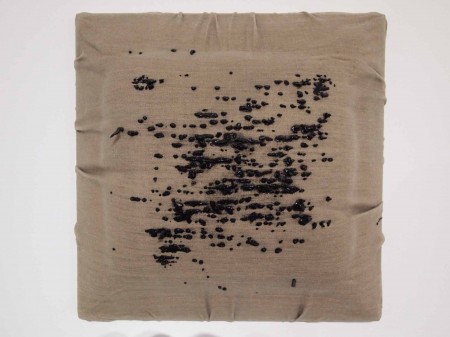
“Discharge #3” illustrates the darker underbelly of these works in a way that is suggestive, not overpowering. It is almost the fraternal twin of “Bulge (Black) #1,” except this bulge is not smooth and perfect but rough linen, with black paint grotesquely seeping from underneath the surface, like blood under a bandage. The bile of domesticity, perhaps—simplicity’s roughness.
Responsibility, here, is to the home, and in Analia Saban’s oeuvre, materials are revolting.
–Joelle Jameson